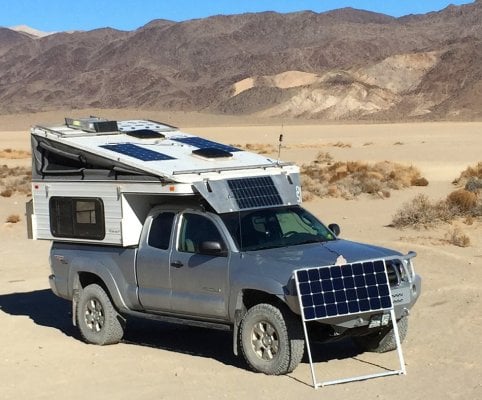RC Pilot Jim
Senior Member
Don,
It's fairly simple to swap out....American RV can do this for you. Important though to get a panel or panels big enough to handle your needs in winter which is reason you need to know the max draw of your various 12 volt devices.
I assume you have the full camper not the shell model . Fan, lights, water pump - minimum use. Same for the furnace maybe a couple of hours per day.
Fridge though is the amp hog.
11.7 volts means the Sure Power probably disconnected the alternator from charging the camper batteries (no warning when this happens). The fridge probably auto shuts off when voltage drops below 12 volts. Results spoiled food.
Our Eagle is mounted full time. Driving it around 2-3 hours a day didn't top off the battery. The Trimetric "tells" me the battery loses charge over time just sitting in the carport. The new 100 watt roof mounted panel does top it off as long as I park truck in the sun.
We don.t have the Iota power converter so installed a small 1.25 amp charger/ maintainer ( battery tender) to keep the battery charged when parked. Sometimes week at a time. Works well.
It's fairly simple to swap out....American RV can do this for you. Important though to get a panel or panels big enough to handle your needs in winter which is reason you need to know the max draw of your various 12 volt devices.
I assume you have the full camper not the shell model . Fan, lights, water pump - minimum use. Same for the furnace maybe a couple of hours per day.
Fridge though is the amp hog.
11.7 volts means the Sure Power probably disconnected the alternator from charging the camper batteries (no warning when this happens). The fridge probably auto shuts off when voltage drops below 12 volts. Results spoiled food.
Our Eagle is mounted full time. Driving it around 2-3 hours a day didn't top off the battery. The Trimetric "tells" me the battery loses charge over time just sitting in the carport. The new 100 watt roof mounted panel does top it off as long as I park truck in the sun.
We don.t have the Iota power converter so installed a small 1.25 amp charger/ maintainer ( battery tender) to keep the battery charged when parked. Sometimes week at a time. Works well.



